Sunnyside Yard Inches Closer to Development
The Wheels have been in Motion Ever Since Mayor de Blasio First Unveiled his Vision for Sunnyside Yard in 2015
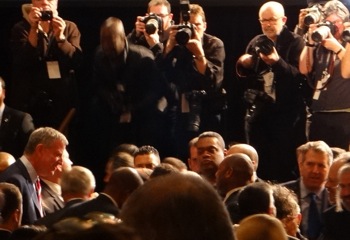 January 7, 2018 / Sunnyside Neighborhood / Long Island City Neighborhood / Queens Neighborhoods / Queens Real Estate LIC Astoria Sunnyside / Queens Buzz NYC.
January 7, 2018 / Sunnyside Neighborhood / Long Island City Neighborhood / Queens Neighborhoods / Queens Real Estate LIC Astoria Sunnyside / Queens Buzz NYC.
On Tuesday, February 3rd, 2015 - in Bill de Blasio's first State of the City Address in Manhattan - the Mayor unveiled a vague vision for for the development of Sunnyside Yard in Queens. Following Mayor de Blasio's announcement, the city initiated a feasibility plan to investigate the issues associated with developing the space atop what is now the open space of Sunnyside Yard. Sunnyside Yard lies near the eastern side of Long Island City and the western side of the Sunnyside neighborhood.
Prior to the Mayor's announcement, and continuing to this day, western Queens - but most specifically Long Island City - has been under siege by real estate developers. They have bid up the prices on old buildings and empty lots, and following the purchase of them, have then erected tall skyscraper buildings at a rapid, mind-boggling pace. By the early 2020's, NYC real estate developers will have added tens of thousands of residential units to the Long Island City neighborhood alone, in less than a decade and a half.
In the photo at right, Mayor de Blasio talking to members of the press and audience, following his first State of the City Address in 2015 in Manhattan.
A Changing & Evolving Landscape in Queens
 Like all change - there are winners and losers and there are good things and bad things - that come of any change. I've tried to capture a bit of both in my reporting of Long Island City's growth over the past decade or so, but for the purpose of this report, I will leave a discussion of the many issues associated with change, here.
Like all change - there are winners and losers and there are good things and bad things - that come of any change. I've tried to capture a bit of both in my reporting of Long Island City's growth over the past decade or so, but for the purpose of this report, I will leave a discussion of the many issues associated with change, here.
In October of 2018 there was a community meeting at LaGuardia Community College regarding future plans for Sunnyside Yard. Over 300 people came to watch the slide show, view the exhibits, and interact with the NYC Economic Development [EDC] team that is spearheading the effort to include community sentiment and address community issues in any future development of Sunnyside Yard.
This is the beginning of an 18 month long process to engage the community in identifying and managing issues associated with the development of Sunnyside Yard.
In the photo at right are various members of the Queens community who came out to view the exhibits and slide show put together by the NYC EDC regarding the future development of Sunnyside Yard.
WORK IN PROGRESS - more to come later this week.
nyc things to do manhattan brooklyn queens bronx staten island things to do events nyc
Real Estate Development: Sunnyside Yard History & NYC Railroad History - Special Report Series
There's Been Talk of Developing the Real Estate of Sunnyside Yard NYC
Updated March 2017 / NYC History & Neighborhoods / Sunnyside Yard & NYC Railroad History / Gotham Buzz NYC.
The following is a series of reports we have run and continue to evolve to provide background and context for the residents and voters of Sunnyside, Long Island City, Astoria, Queens, and perhaps NYC, to use to evaluate the respective pros and cons of public policy with regard to the future development of Sunnyside Yard.
The first report is a brief history of Sunnyside Yard, most of which we picked up in a book presentation by historian / author Dave Morrison at the Greater Astoria Historical Society.
The second report provides a summary overview of the development of Queens in the 19th and 20th centuries. Showing how the development of transportation affected real estate development in Queens.
The third report takes a deeper dive into the 20th century development, exploring the same line of thought with regard to the interwoven importance of transportation and real estate development.
The fourth report is expected in late April, which will show the 20th century history of development - the specifics of which will be arriving shortly.
- CLICK here for our section reporting on the real estate development at Sunnyside Yard in Queens.
Real Estate Development: Sunnyside Yard History & NYC Railroad History - Special Report Series
There's Been Talk of Developing the Real Estate of Sunnyside Yard NYC
Updated March 2017 / NYC History & Neighborhoods / Sunnyside Yard & NYC Railroad History / Gotham Buzz NYC.
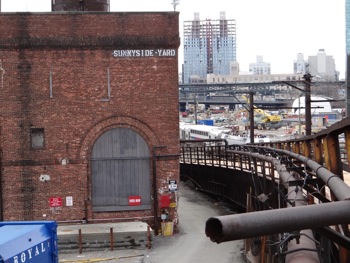 The following is a series of reports we have run and continue to evolve to provide background and context for the residents and voters of Sunnyside, Long Island City, Astoria, Queens, and perhaps NYC, to use to evaluate the respective pros and cons of public policy with regard to the future development of Sunnyside Yard.
The following is a series of reports we have run and continue to evolve to provide background and context for the residents and voters of Sunnyside, Long Island City, Astoria, Queens, and perhaps NYC, to use to evaluate the respective pros and cons of public policy with regard to the future development of Sunnyside Yard.
The first report is a brief history of Sunnyside Yard, most of which we picked up in a book presentation by historian / author Dave Morrison at the Greater Astoria Historical Society.
The second report provides a summary overview of the development of Queens in the 19th and 20th centuries. Showing how the development of transportation affected real estate development in Queens.
The third report takes a deeper dive into the 20th century development, exploring the same line of thought with regard to the interwoven importance of transportation and real estate development.
The fourth report is expected in late April, which will show the 20th century history of development - the specifics of which will be arriving shortly.
- CLICK here for our section reporting on the real estate development at Sunnyside Yard in Queens.
1423
Over a Century of Railroad History in Sunnyside Yard
Railroad Historian Dave Morrison Brings Back to Life the Glorious Past of the Queens Rail Yard & the Hell Gate Bridge at the Greater Astoria Historical Society
January 15, 2017 / NYC History & Neighborhoods / Sunnyside Yard & NYC Railroad History / Gotham Buzz NYC.
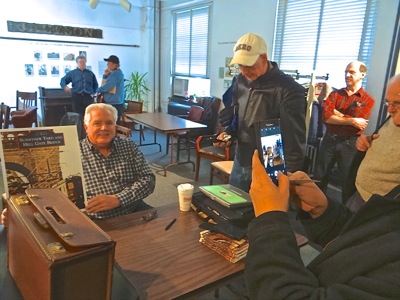 On Saturday afternoon I attended a lecture and book signing event at the Greater Astoria Historical Society in the Quinn Building, only blocks from the Museum of the Moving Image. The book is entitled Sunnyside Yard and the Hell Gate Bridge and it was written by Railroad Historian Dave Morrison of Plainview, New York. The Greater Astoria Historical Society hosted the event as part of its Hell Gate Centennial commemoration efforts.
On Saturday afternoon I attended a lecture and book signing event at the Greater Astoria Historical Society in the Quinn Building, only blocks from the Museum of the Moving Image. The book is entitled Sunnyside Yard and the Hell Gate Bridge and it was written by Railroad Historian Dave Morrison of Plainview, New York. The Greater Astoria Historical Society hosted the event as part of its Hell Gate Centennial commemoration efforts.
It didn't take Dave long to convince those of us in attendance that he was not only an expert in the subject, but also a passionate railroad history aficionado. Dave's presentation included photos from the book, as well as many other photos he'd collected which didn't make it into the book. In the photo at right, Dave Morrison signed a number of copies of his new book, Sunnyside Yard & the Hell Gate Bridge, following his presentation of excerpts from it at the Greater Astoria Historical Society.
Dave began his story in Brooklyn, in the mid 1800's, when the residents of Brooklyn protested building a train rail yard in the borough because of all the noise, dirty coal steam and traffic it would bring to the fast growing, bustling borough.
Click here to read the rest of the story, including a photos, of the presentation made by Dave Morrison about the history of Sunnyside Yard, NYC Railroads and the Hell Gate Bridge.
1424
Sunnyside Yard: Finding Our Place In Space & Time
Part I. A Closer Look Into The Many Dimensions Of The Mayor's Proposed Development Of Sunnyside Yard
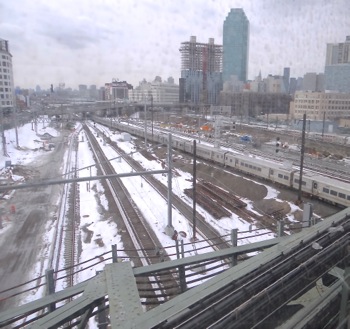 Updated March 2017 / First Posted March 8, 2015 / NYC History & Neighborhoods / Sunnyside Yard & NYC Railroad History / Gotham Buzz NYC.
Updated March 2017 / First Posted March 8, 2015 / NYC History & Neighborhoods / Sunnyside Yard & NYC Railroad History / Gotham Buzz NYC.
There's been plenty of talk about the proposed real estate development of Sunnyside Yard since Mayor de Blasio first announced it as one of the top real estate development sites that could be used to mitigate New York City's current affordable housing crisis.
I've been taking an informal poll about the proposed development, and generally have heard people voice their opposition to it, even though the proposal is still in the early stages. To be sure, there are plenty of issues associated with the real estate development which one could easily construe to be negative [like the population density impact on infrastructure], but there are also opportunities associated with it, which one could see in a positive light [like tying funding for more transit to address the stress already on the #7 subway line].
The photo at right shows one section of the Sunnyside Yard looking south from Queens Blvd, just east of Jackson Avenue in Long Island City.
What follows is a deeper look into the proposed development of the Sunnyside Yard. This is our first report in a series. For Part II of this series, click the link at the end of the story entitled Sunnyside Yard.
1425
Sunnyside Yards: Finding Our Place In Space & Time
Part II. History Of Transit & Housing In Queens: Sunnyside Yards
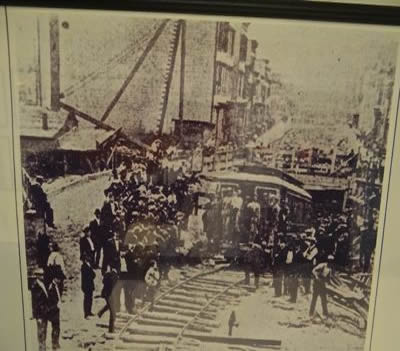 March 18, 2015 / Sunnyside / NYC History & Neighborhoods / Sunnyside Yard & NYC Railroad History / Gotham Buzz NYC.
March 18, 2015 / Sunnyside / NYC History & Neighborhoods / Sunnyside Yard & NYC Railroad History / Gotham Buzz NYC.
Click here to view our section dedicated to Sunnyside Yard History & real estate development.
In Part I of this report series about Mayor de Blasio's proposed development of Sunnyside Yards, we saw how Queens evolved from the rolling woods and farmlands of the early 19th century, into an industrial and manufacturing center along the East River waterfront in the second half of that century. In 1898 Queens became a part of New York City and the dawn of the 20th century had begun.
Work On The Steinway Tunnel Resumes & Begins The Era Of The Commute
In 1892 William Steinway [he died in 1896] began digging a tunnel underneath the East River between Queens and Manhattan. He had envisioned completing it to enable mass transit flows between Queens and Manhattan to enhance the value of his vast Astoria / Long Island City real estate holdings, but he died before that vision came to fruition. The Steinway Tunnel, which was named in his honor and which it carries to this day, is now the underground tunnel for the #7 subway line between Flushing Main Street in Queens, and Times Square in Manhattan. I shot the photo to right at a LaGuardia Community College exhibit in LIC which shows a newspaper account of a 1907 test run of a trolley through the line, three years after the completion of the Steinway Tunnel between Manhattan and Queens in 1904.
Large Scale Real Estate Development Begins In Queens
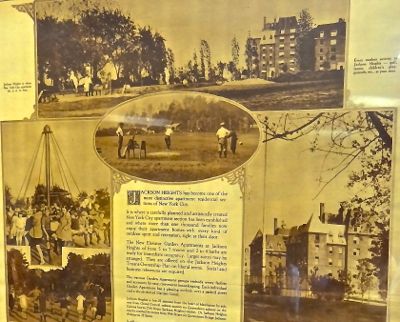 Following the creation of the interborough subway lines, affordable housing developments followed in Jackson Heights, Forest Hills and Sunnyside. The photo at right shows a 1922 real estate development in Jackson Heights built for the upwardly mobile growing middle class. I shot this photo at the Jackson Heights Beautification Group's Historic House [Garden] Tour Weekend.
Following the creation of the interborough subway lines, affordable housing developments followed in Jackson Heights, Forest Hills and Sunnyside. The photo at right shows a 1922 real estate development in Jackson Heights built for the upwardly mobile growing middle class. I shot this photo at the Jackson Heights Beautification Group's Historic House [Garden] Tour Weekend.
We ended Part I talking about Public Housing that ultimately became low income housing, and which had systemic problems attributed to the civil rights struggle of the mid 20th century, and which was followed by social upheaval accompanied by narcotics. While remnants of the past remain with us, the most egregious aspects of these historical issues have been ameliorated.
And so we begin Part II by taking a deeper dive into the evolution of New York City's transportation system and housing development, with an eye toward how mass transit and the auto enabled the daily movement of millions of people / workers between their workplaces in Manhattan to their homes in the outer boroughs - most notably of Queens.
What follows is Part II of a deeper look into the Mayor's proposed development of the Sunnyside Yard to mitigate affordable housing in NYC.
1426
Sunnyside Yard: Part III
Feasibility, Functionality, Public Policy & Community Strategies
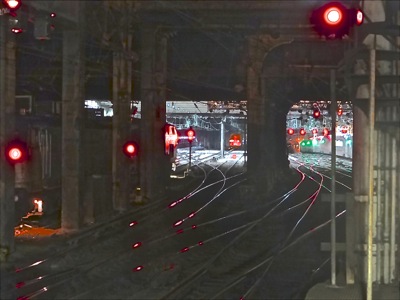 Published March 23, 2017 / Drafted May 18, 2015 / Long Island City / NYC History & Neighborhoods / Sunnyside Yard & NYC Railroad History / Gotham Buzz NYC.
Published March 23, 2017 / Drafted May 18, 2015 / Long Island City / NYC History & Neighborhoods / Sunnyside Yard & NYC Railroad History / Gotham Buzz NYC.
In the first two segments of our series on the Sunnyside Yard we took a look at the centuries old history of transit and real estate development in Queens as the two went hand in hand.
In this report we're going to explore the feasibility and functionality of building over Sunnyside Yard by looking at the history of platform development over rail yards and highways in New York City since the turn of the 20th century.
This will be followed by a brief look at some of the economics of the Hudson Yard platform development in West Midtown, which will be used to make a calculated estimate of the cost of erecting various sized platforms over the Sunnyside Rail Yard.
Urban Density Measures: People per Square Foot of Land or Living Space Per Person?
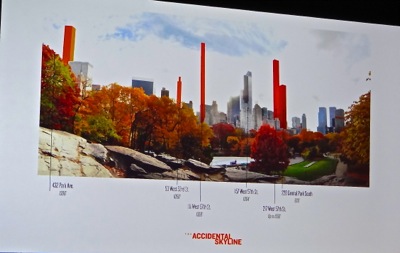 We will also look at two very different measures of population density. One metric is people per square foot of land and the other is the amount of living space per person.
We will also look at two very different measures of population density. One metric is people per square foot of land and the other is the amount of living space per person.
The first metric - the population density per square foot of land - can be managed by ensuring the proper amount of public infrastructure is in place. Public infrastructure including open space, pedestrian space, parklands, public transit conduits, schools and libraries.
The second metric - living space per person - can be managed by creating more space by buidling upward.
Affordable Housing: Public Financing of Rentals or Ownership?
Before completing this report we will include a brief look into the history of government lead efforts to address affordable housing shortages in New York City in the past. Generally public / private collaborative housing developments have resulted in the erection of price controlled rental apartments, of which the ownership was given to private real estate developers and financiers.
Home ownership is one of the most important components of wealth creation and upward social / economic mobility in America. Hence, in this report we will also show how significantly household wealth is affected by ownership / lack of ownership of one's residence.
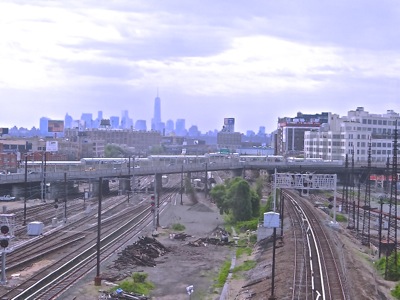 We will explore the possibility of distributing the ownership of affordable housing units to those who reside in them, as an alternative to what has been done in the past. The economics of which can be made feasible by taking New York Central Railroad visionary Wilbur J. Wilgus's advice by "creating wealth from the air", by building up. This alternative makes economically possible, government efforts to enable citizens to own their own homes.
We will explore the possibility of distributing the ownership of affordable housing units to those who reside in them, as an alternative to what has been done in the past. The economics of which can be made feasible by taking New York Central Railroad visionary Wilbur J. Wilgus's advice by "creating wealth from the air", by building up. This alternative makes economically possible, government efforts to enable citizens to own their own homes.
This goal of examining an alternative approach to government efforts to address New York City's affordable housing crisis is that this approach is in alignment with the ideals of the American Revolution which took governance by the few [Kings and Nobles] and distributed it to the nation's citizenry. Self-determination. Self-governance. Home-Ownership.
The distribution of home ownership also simultaneously strikes at one of the root causes of the shrinking American middle class, by mitigating one of the chief causes of the growing disparity of wealth accumulation of American citizens.
We will end this report with a look at different strategies that the community / neighborhood can explore to block, guide or embrace a real estate development over Sunnyside Yard.
Fasten your seat belt. And click here for Part III of our series regarding the real estate development of Sunnyside Yard and affordable housing solutions in NYC.
1427
Sunnyside Yard & Affordable Housing: Real Estate Development
Published March 23, 2017 / Drafted May 18, 2015 / Long Island City / NYC History & Neighborhoods / Sunnyside Yard & NYC Railroad History / Gotham Buzz NYC.
This report is part of a series which you can find at - Real Estate Development of Affordable Housing in NYC: Sunnyside Yard.
As this report constitutes a deep dive into the various aspects of developing residential housing over Sunnyside Yard in Queens, I've provided the following Directory so you can click to view a section or scroll through the work in its entirety.
- Perpetual Tenants: The History of Government Funding of Publicly & Privately Owned Rentals
- Public Policy Goals: To Create Apt Rentals or Create Apt Owners
- Community Approach To Sunnyside Yard Development
I. Perpetual Tenants: The History of Government Funding of Publicly & Privately Owned Rentals
Public Investments / Private Ownership / Regulated Rents
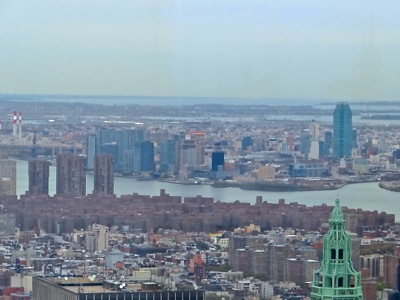 Past efforts to address New York City's housing crises have only mitigated the problem temporarily, as evidenced by periodic flare ups.
Past efforts to address New York City's housing crises have only mitigated the problem temporarily, as evidenced by periodic flare ups.
In the 1940's Stuyvesant Town / Peter Cooper Village was one of the first public private partnerships designed to address what at the time was a temporary affordable housing shortage. The city helped demolish the housing in and around the old ash piles [CONFIRM] of the east side east of First Avenue and between 14th and 23rd Streets in order to erect a number of high rises in their place. Hence the erection of Stuyvesant Town / Peter Cooper Village.
My general understanding is that the government cleared the land and helped Met Life Company make the financials work through government tax abatements and financing. The company [MetLife] built the housing complexes and henceforth provided New York City residents with rent stabilized housing.
At the time [1940's] some community activists were concerned that the development would create an overly dense population zone. As you can see from the photos showing much higher buildings around the Stuyvestant Town / Peter Cooper Village complex, that times have changed.
Government Builds & Rents Housing Complexes
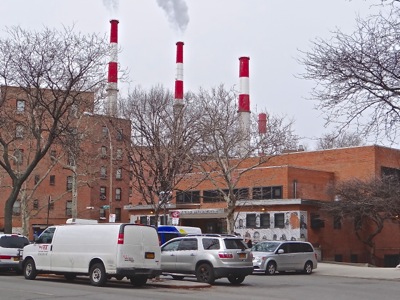 This public / private effort was both preceded and followed by government lead housing efforts made via the collaboration of various levels of government agencies to create affordable housing.
This public / private effort was both preceded and followed by government lead housing efforts made via the collaboration of various levels of government agencies to create affordable housing.
In Queens, the Queens Bridge Housing project, Ravenswood Housing project, Astoria Houses - to name but only a few in western Queens - arose during this period. These public housing projects are maintained by the government and rented to low and moderate income families.
The photo at right shows Queens Bridge Public Housing Project which is located north of Queens Bridge and adjacent to a Con Edison power plant.
GI Loans, Housing Ownership & The Growth of the Middle Class
During the 1940's and 1950's there was a 'white flight' as many of the Caucasians living in these projects were able to move out during America's economic heyday. Following WWII the United States was about the only nation left standing with a very modern and totally functioning economy. Lower and middle income citizens were able to buy homes in the suburbs - as this was made possible by low interest GI loans - and it spurred the growth of what we've come to know as the American middle class.
Click here to continue reading the rest of our report about affordable housing in NYC & Sunnyside Yard real estate development.
Gotham Buzz Voluntary Single Copy Sales or Subscriptions
We're not independently wealthy. So if you like what we're doing, you can help us continue to provide you with this coverage and possibly expand it, by voluntarily paying for a single copy or by subscribing to Gotham Buzz. Click  the button for details on how to make a purchase for as little as $5 which is less than what you'd pay for one issue of a magazine.
the button for details on how to make a purchase for as little as $5 which is less than what you'd pay for one issue of a magazine.
NYC Neighborhood & NYC History - Related Links
Click on these advertisements for promotions, discounts and coupons by retailers and restaurateurs in Woodside, Sunnyside and nearby Queens.
Several years ago, during the Bloomberg Administration, the Hunters Point South development & affordable housing NYC was approved by Community Board 2 and subsequently approved by the New York City Council and Mayor Bloomberg. Click the link above to read the earlier report. Click these links to gain a broader perspective of the Long Island City Neighborhood in which these units reside.
Click this link to go to the:
Sunnyside & Woodside Neighborhood
Site Search Tips. 1) For best results, when typing in more than one word, use quotation marks - eg "Astoria Park". 2) Also try either singular or plural words when searching for a specific item such as "gym" or "gyms".
$element(bwcore,insert_search,N)$
Click the log in link below to create an ID and post an opinion.
Or send this story to a friend by filling in the appropriate box below.
















